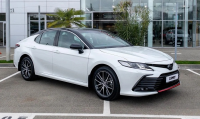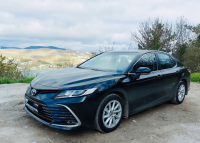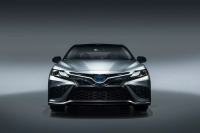The new 2017 Toyota Camry XV70 is out, and demand for it is only increasing as ever. It's the eighth generation and there are a lot of complaints about it. Today we'll explore all sides of the new Japanese business class and talk about the flaws that make it considered worse than the XV50.
The model was presented at the Detroit auto show, and a year later it entered the EU market, where it is much loved. This time it got rid of the American and European versions, which previously differed globally. There are many changes here, but some parts have remained the same.
,-but-more-substandard-1.png)
Contents:
Design
Down with conservatism - interior
Partial update of the equipment
Price and equipment packages
Many dissatisfied - disadvantages
Conclusion
Test drive video
Design
The face of the new Toyota Camry
This is the strongest feature of the new sedan, if Toyota used to lag behind the competition by doing something more conservative. Now it has equalled its competitors, and even surpassed some.
At the front, the car gets new narrow all-LED headlights, with a recessed line with the company logo running between them. Most of the bumper of the new Camry 2021-2022 now consists of a convex grille with stylish lines. Below that, there's a recessed headlight and the bumper juts forward into a lip-like shape.
Side
The wonderment continues on the side. The shape of the sedan with its deepening of the bonnet and swollen rear with powerful struts looks unusual. The wheel arches are not badly inflated giving muscularity. Arches are equipped with 16-inch wheels in base and 18-inch ones in top. The top line which cuts through the door handles and of course the powerful rear-view mirror on the leg deserves special attention.
,-but-more-substandard-3.png)
At the rear, the convex underside of the wings remains, making for a raised boot lid. The lid itself looks beautiful, forming a small anti-fender in its shape. The rear LED headlights are also narrow, and at night they accentuate the rigour of the shape. The bumper has a convex shape that deepens to the bottom, where the plastic covers and reflectors are fitted.
Rear
Toyota Camry sedan dimensions:
length - 4879 mm;
width - 1839 mm;
height - 1445 mm;
wheelbase - 2825 mm;
ground clearance - 160 mm.
The EU market is limited to only 6 paint colours: white, black, taupe, silver, navy blue and white pearl.
,-but-more-substandard-4.png)
The appearance turned out gorgeous, thus the Japanese are trying to win over the young audience, which will expand sales. There were cases when the owners surrendered the new Mazda 6 in trade-in and took the "Dream to drive". But, there are complaints about the design, about which at the end.
Down with conservatism - interior
Interior photo of the new Toyota Camry
Everything has changed inside, except for a steering wheel, though there are slight innovations in it too. Leather (black or beige), soft plastic and inserts of fake wood are used in upholstery. There are a lot of complaints about the build quality. The manufacturer has gone for functionality here.
At the front, they have put other seats, sporting anatomic style architecture. Toyota Camry 2021-2022 seats are soft, comfortable, electrically adjustable, equipped with heating and ventilation in the top. There's certainly plenty of space in the back, but the car used to be the leader in rear-row space, now it's not. In the top, a folding centre armrest gets touch-sensitive buttons for backrest angle adjustment, heating and its own climate control.
,-but-more-substandard-5.png)
Front seatsRear sofa
The first thing the driver sees is a 3-spoke multi steering wheel, behind which is a dashboard with recessed analogue gauges and a central 7-inch screen. The top is fitted with a 10-inch projection.
Dashboard
What people like most visually is the centre console, with its glossy bezel, triangular surrounds and overall picture will tell you more. On the glossy console sits the 8-inch Toyota Entune 3.0 multimedia display. Inserted below is the intuitive climate control unit, which in the top is 3-zone. The Camry's glossy dash looks nice, but is heavily patched.
Optionally, the sedan's audio system gets 10 speakers and a JBL subwoofer. The system is complemented by Clari-Fi technology, which analyses the track and restores its quality.
Multimedia of the new Camry XV70Camry Tunnel 2021-2022
The centre tunnel along with the console transition looks stylish. At its base is an area with wireless charging. Further down is the transmission lever, a pair of cupholders, drive mode selection buttons and electronic handbrake.
A partial tech upgrade
Type Volume Torque Acceleration Maximum speed Number of cylinders
Petrol 2.0 litre 150 hp 192 H*m 11 sec. 210 km/h 4
Petrol 2.5 litre 181 hp 231 H*m 9.9 sec. 210 km/h 4
Gasoline 3.5L 249 hp 356 H*m 7.7 sec. 220 km/h V6
Read more at
Let's get straight to the suspension, because this is the most important innovation. The car moved to a new modular platform TNGA, or more precisely its modification GA-K. Suspension in the front is on McPherson struts, and multilever architecture in the back is established. Thus, the engineers have shifted the focus from wobbly sofa to steerability.
In reality, the sedan is steering better, helped by a more informative power unit, but you quickly realise that cornering is a dangerous business. The Toyota Camry XV70 is a long way from its European handling.
Blue new Toyota Camry
The engine lineup remains the old one:
A 2-litre 6AR-FSE, producing 150 horsepower and 192 H*m of torque. 11 seconds to a hundred? That's a bit weak! According to the passport it consumes 9.7 litres.
The most popular 2.5-liter 2AR-FE with 181 horses and 231 units of torque. Dynamics are also poor, with 10 seconds and 11.5 litres of consumption.
Top is the 3.5-litre V6 2GR-FKS with 249 horsepower and 356 H*m of torque. Acceleration to a hundred takes 7.7 seconds and fuel consumption goes up by just a litre.
Why has the same power made the dynamics worse, the weight? No, the environmental "collars", which you can certainly cut out, but you'll have to say goodbye to the warranty.
By the way, a hybrid version with 2.5-litre engine and electric THS-II is available in other markets. A motor of Toyota Camry 2021-2022 is coupled with a variator gearbox, and power is in three versions: 178, 208, 218 horsepower.
Photo of Toyota Camry XV70 at night
The first engines were paired with 6-speed automatic gearbox, the top unit ruined its power, so it was supplied with 8-speed automatic Direct Shift-8AT. All versions are front-wheel drive. Disc brakes with a pack of known safety systems: ABS, VSC+, EBD, BAS, TCS, DAC.
Price and equipment
The buyer is offered 7 options with different levels of equipment, but as it turned out, the base is already pretty good. The entry-level version, being equipped with:
2-zone climate control;
LED headlights with light sensor;
cloth interior trim;
6-speaker audio system;
central multimedia display;
16-inch rims;
fog lights;
4.2-inch dashboard display.
The top version Executive Safety costs much more, because in addition to the extras you get safety systems and a top 3.5-liter engine. The price is 20 000 USD, and the Camry will be equipped with
18-inch wheels;
other architecture of light-emitting diode optics;
electric adjustable steering wheel;
7-inch dashboard display;
keyless entry;
leather upholstery;
electric seat adjustment with memory;
heated two side and ventilated front;
rear sofa backrest adjustment;
3-zone climate control;
heated steering wheel;
lane-keeping system;
blind spot monitoring;
road sign monitoring;
driver fatigue sensor;
all-around vision system;
JBL audio system;
navigation;
wireless charging;
adaptive cruise control with distance assist;
Nano-e air ioniser.
Yes, the manufacturer's move towards functionality is immediately apparent.
Lots of dissatisfaction - shortcomings
There are a lot of negative reviews on the internet, which converge on a single conclusion - a strong decline in quality. Starting with the body, the metal is easily crumpled, as if made of "foil". The same goes for the interior, for example the central tunnel can be bumped by hands, or after half a year it can lose the marketable look of the leather panelling or supposedly wooden inserts.
The car has never been the quietest, but there is often whistling from the mirrors and a lot of noise from the wheel arches on the highway. Many have encountered the squeaking of the Camry's windscreen in winter, which rubs against the plastic clips of the torpedo. Dealers simply remove these clips, which are of no technical use - it's strange.
Rear of the Camry XV70 at night
The poor handling bias has reduced the expected comfort from the eighth generation. Greater smoothness of ride was expected. The handling couldn't be forced on the car, the understeer persisted.
The installation of the old engines is disappointing, yes they have shown themselves well, but something new would have been desirable. Also, pricing of spare parts surprises - in some places it is ahead of Germans. The headlight, for example, costs 1500 USD.
Conclusion
Yes, improvements of design and functionality of Japanese business class will bring a lot of young buyers. Sales will still be great, but a lot of complaints will badly damage the reputation of the brand.
Whether or not to buy yourself a Toyota Camry XV70 (2021-2022) depends on your purpose. If you need a reliable and super-quality car that's slowly getting cheaper, it can't provide that anymore. If you just want a versatile, good-looking, relatively inexpensive business sedan, it's one of the best on the market.
,-but-more-substandard-2.png)



